Sustainable Tourism Development Report: Cola Beach, Goa Analysis
VerifiedAdded on 2019/12/03
|12
|3837
|177
Report
AI Summary
This report provides a comprehensive analysis of sustainable tourism development, using Cola Beach in Goa, India, as a case study. It begins by identifying key tourism stakeholders such as the government, local people, and private enterprises, and discusses the benefits of public-private partnerships in tourism development. The report then outlines the key steps in the tourism development process, emphasizing the significance of interactive planning involving all stakeholders. It examines the economic, social, and environmental impacts of tourism, along with methods to measure these impacts. The concept of sustainability in tourism is explored, addressing the challenges and hindrances to sustainable development, and detailing the stages involved in developing sustainable tourism at Cola Beach. Furthermore, the report addresses conflicts of interest, supply and demand balance, and enclave tourism. Finally, it compares Cola Beach with other emerging tourist destinations, projecting the future development of tourism in both locations. The report concludes with a summary of the key findings and recommendations for sustainable tourism development.
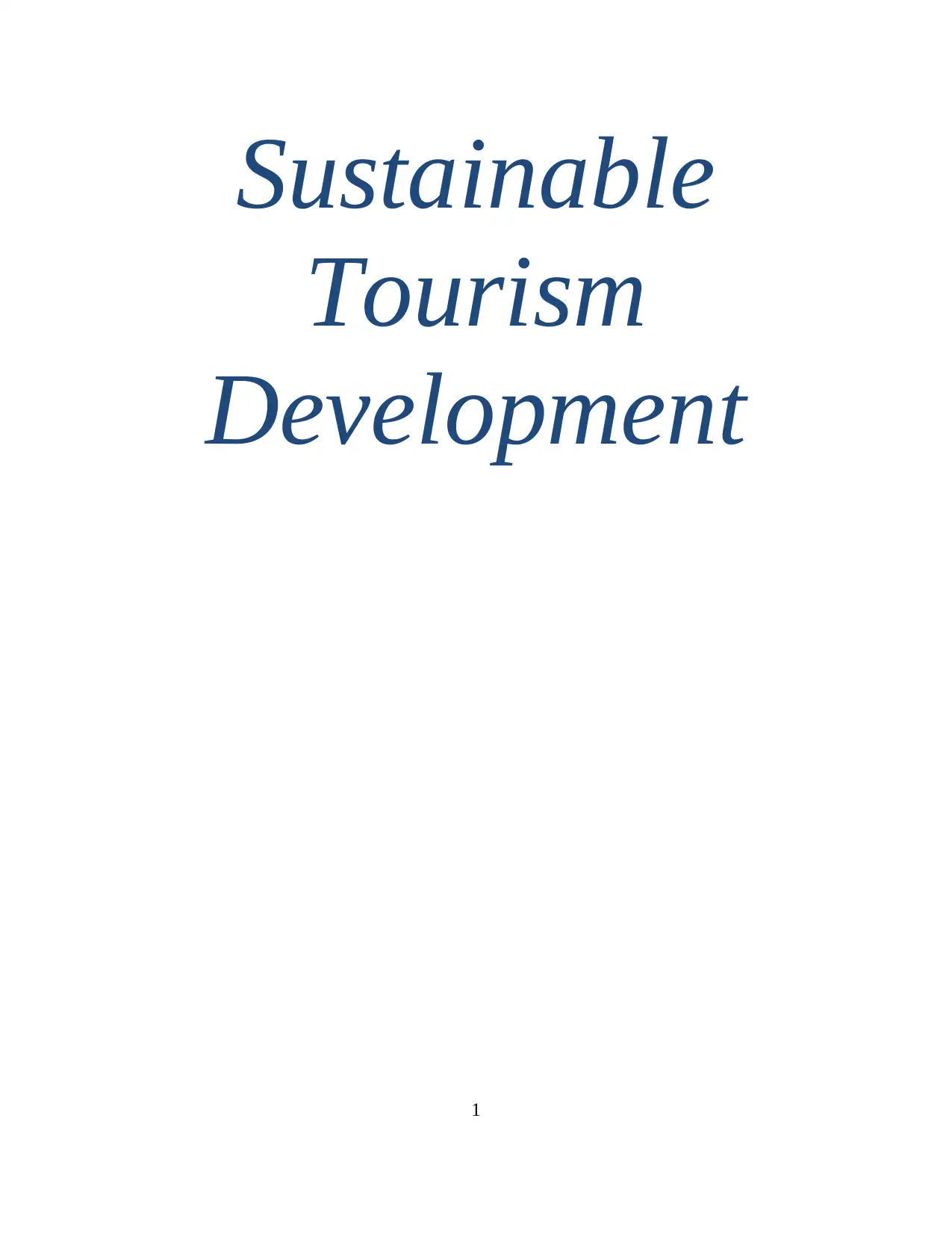
Sustainable
Tourism
Development
1
Tourism
Development
1
Paraphrase This Document
Need a fresh take? Get an instant paraphrase of this document with our AI Paraphraser
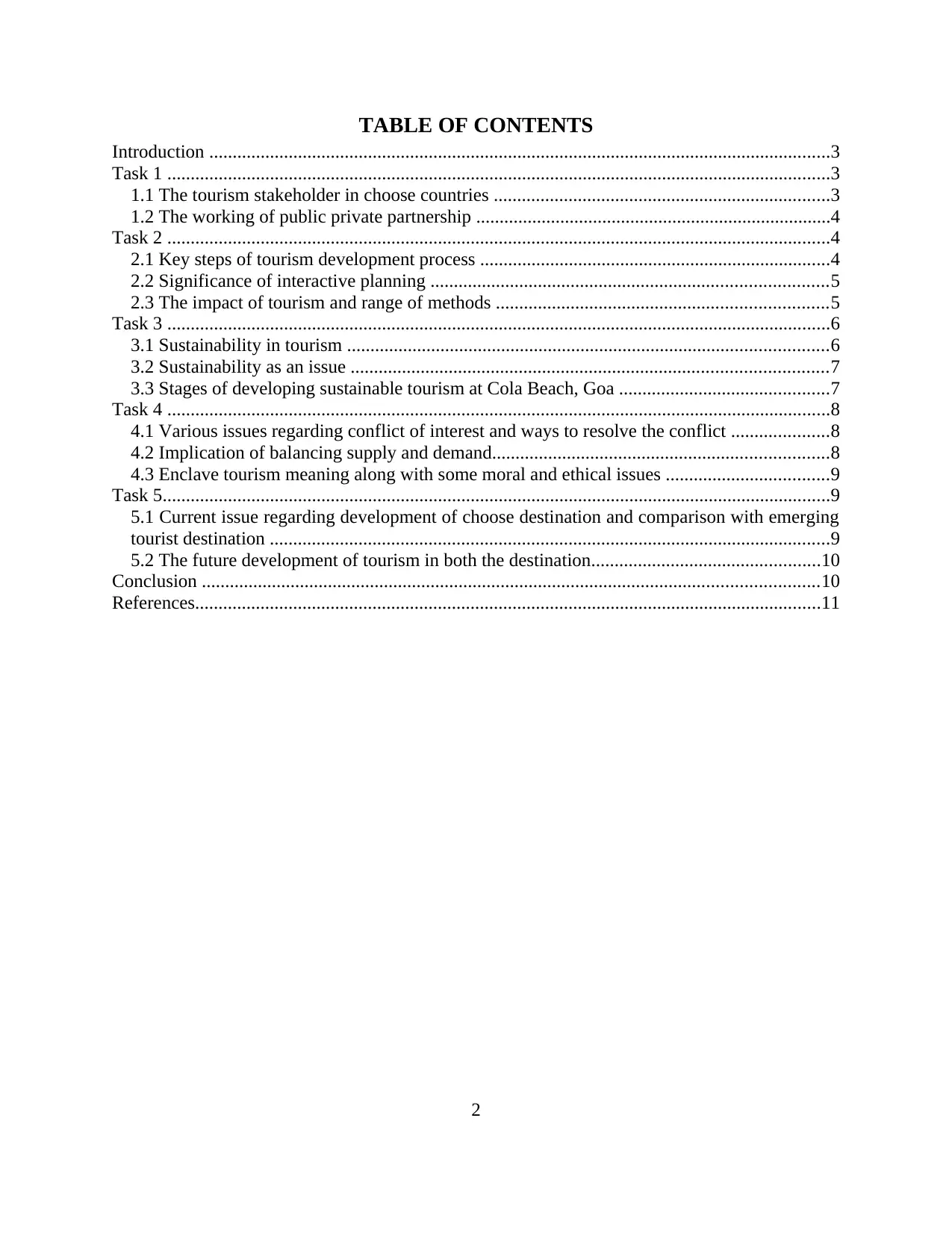
TABLE OF CONTENTS
Introduction .....................................................................................................................................3
Task 1 ..............................................................................................................................................3
1.1 The tourism stakeholder in choose countries ........................................................................3
1.2 The working of public private partnership ............................................................................4
Task 2 ..............................................................................................................................................4
2.1 Key steps of tourism development process ...........................................................................4
2.2 Significance of interactive planning .....................................................................................5
2.3 The impact of tourism and range of methods .......................................................................5
Task 3 ..............................................................................................................................................6
3.1 Sustainability in tourism .......................................................................................................6
3.2 Sustainability as an issue ......................................................................................................7
3.3 Stages of developing sustainable tourism at Cola Beach, Goa .............................................7
Task 4 ..............................................................................................................................................8
4.1 Various issues regarding conflict of interest and ways to resolve the conflict .....................8
4.2 Implication of balancing supply and demand........................................................................8
4.3 Enclave tourism meaning along with some moral and ethical issues ...................................9
Task 5...............................................................................................................................................9
5.1 Current issue regarding development of choose destination and comparison with emerging
tourist destination ........................................................................................................................9
5.2 The future development of tourism in both the destination.................................................10
Conclusion ....................................................................................................................................10
References......................................................................................................................................11
2
Introduction .....................................................................................................................................3
Task 1 ..............................................................................................................................................3
1.1 The tourism stakeholder in choose countries ........................................................................3
1.2 The working of public private partnership ............................................................................4
Task 2 ..............................................................................................................................................4
2.1 Key steps of tourism development process ...........................................................................4
2.2 Significance of interactive planning .....................................................................................5
2.3 The impact of tourism and range of methods .......................................................................5
Task 3 ..............................................................................................................................................6
3.1 Sustainability in tourism .......................................................................................................6
3.2 Sustainability as an issue ......................................................................................................7
3.3 Stages of developing sustainable tourism at Cola Beach, Goa .............................................7
Task 4 ..............................................................................................................................................8
4.1 Various issues regarding conflict of interest and ways to resolve the conflict .....................8
4.2 Implication of balancing supply and demand........................................................................8
4.3 Enclave tourism meaning along with some moral and ethical issues ...................................9
Task 5...............................................................................................................................................9
5.1 Current issue regarding development of choose destination and comparison with emerging
tourist destination ........................................................................................................................9
5.2 The future development of tourism in both the destination.................................................10
Conclusion ....................................................................................................................................10
References......................................................................................................................................11
2
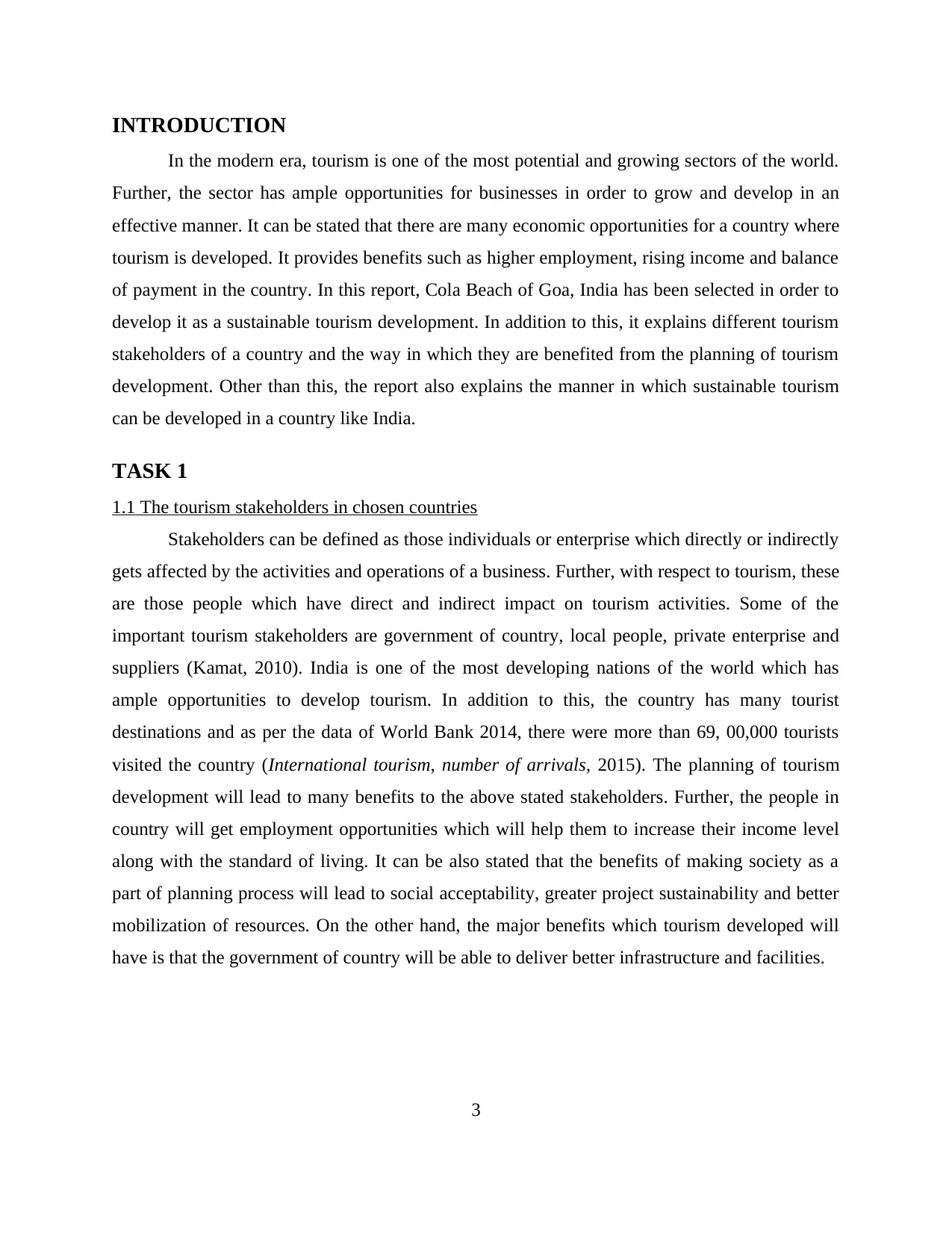
INTRODUCTION
In the modern era, tourism is one of the most potential and growing sectors of the world.
Further, the sector has ample opportunities for businesses in order to grow and develop in an
effective manner. It can be stated that there are many economic opportunities for a country where
tourism is developed. It provides benefits such as higher employment, rising income and balance
of payment in the country. In this report, Cola Beach of Goa, India has been selected in order to
develop it as a sustainable tourism development. In addition to this, it explains different tourism
stakeholders of a country and the way in which they are benefited from the planning of tourism
development. Other than this, the report also explains the manner in which sustainable tourism
can be developed in a country like India.
TASK 1
1.1 The tourism stakeholders in chosen countries
Stakeholders can be defined as those individuals or enterprise which directly or indirectly
gets affected by the activities and operations of a business. Further, with respect to tourism, these
are those people which have direct and indirect impact on tourism activities. Some of the
important tourism stakeholders are government of country, local people, private enterprise and
suppliers (Kamat, 2010). India is one of the most developing nations of the world which has
ample opportunities to develop tourism. In addition to this, the country has many tourist
destinations and as per the data of World Bank 2014, there were more than 69, 00,000 tourists
visited the country (International tourism, number of arrivals, 2015). The planning of tourism
development will lead to many benefits to the above stated stakeholders. Further, the people in
country will get employment opportunities which will help them to increase their income level
along with the standard of living. It can be also stated that the benefits of making society as a
part of planning process will lead to social acceptability, greater project sustainability and better
mobilization of resources. On the other hand, the major benefits which tourism developed will
have is that the government of country will be able to deliver better infrastructure and facilities.
3
In the modern era, tourism is one of the most potential and growing sectors of the world.
Further, the sector has ample opportunities for businesses in order to grow and develop in an
effective manner. It can be stated that there are many economic opportunities for a country where
tourism is developed. It provides benefits such as higher employment, rising income and balance
of payment in the country. In this report, Cola Beach of Goa, India has been selected in order to
develop it as a sustainable tourism development. In addition to this, it explains different tourism
stakeholders of a country and the way in which they are benefited from the planning of tourism
development. Other than this, the report also explains the manner in which sustainable tourism
can be developed in a country like India.
TASK 1
1.1 The tourism stakeholders in chosen countries
Stakeholders can be defined as those individuals or enterprise which directly or indirectly
gets affected by the activities and operations of a business. Further, with respect to tourism, these
are those people which have direct and indirect impact on tourism activities. Some of the
important tourism stakeholders are government of country, local people, private enterprise and
suppliers (Kamat, 2010). India is one of the most developing nations of the world which has
ample opportunities to develop tourism. In addition to this, the country has many tourist
destinations and as per the data of World Bank 2014, there were more than 69, 00,000 tourists
visited the country (International tourism, number of arrivals, 2015). The planning of tourism
development will lead to many benefits to the above stated stakeholders. Further, the people in
country will get employment opportunities which will help them to increase their income level
along with the standard of living. It can be also stated that the benefits of making society as a
part of planning process will lead to social acceptability, greater project sustainability and better
mobilization of resources. On the other hand, the major benefits which tourism developed will
have is that the government of country will be able to deliver better infrastructure and facilities.
3
⊘ This is a preview!⊘
Do you want full access?
Subscribe today to unlock all pages.

Trusted by 1+ million students worldwide
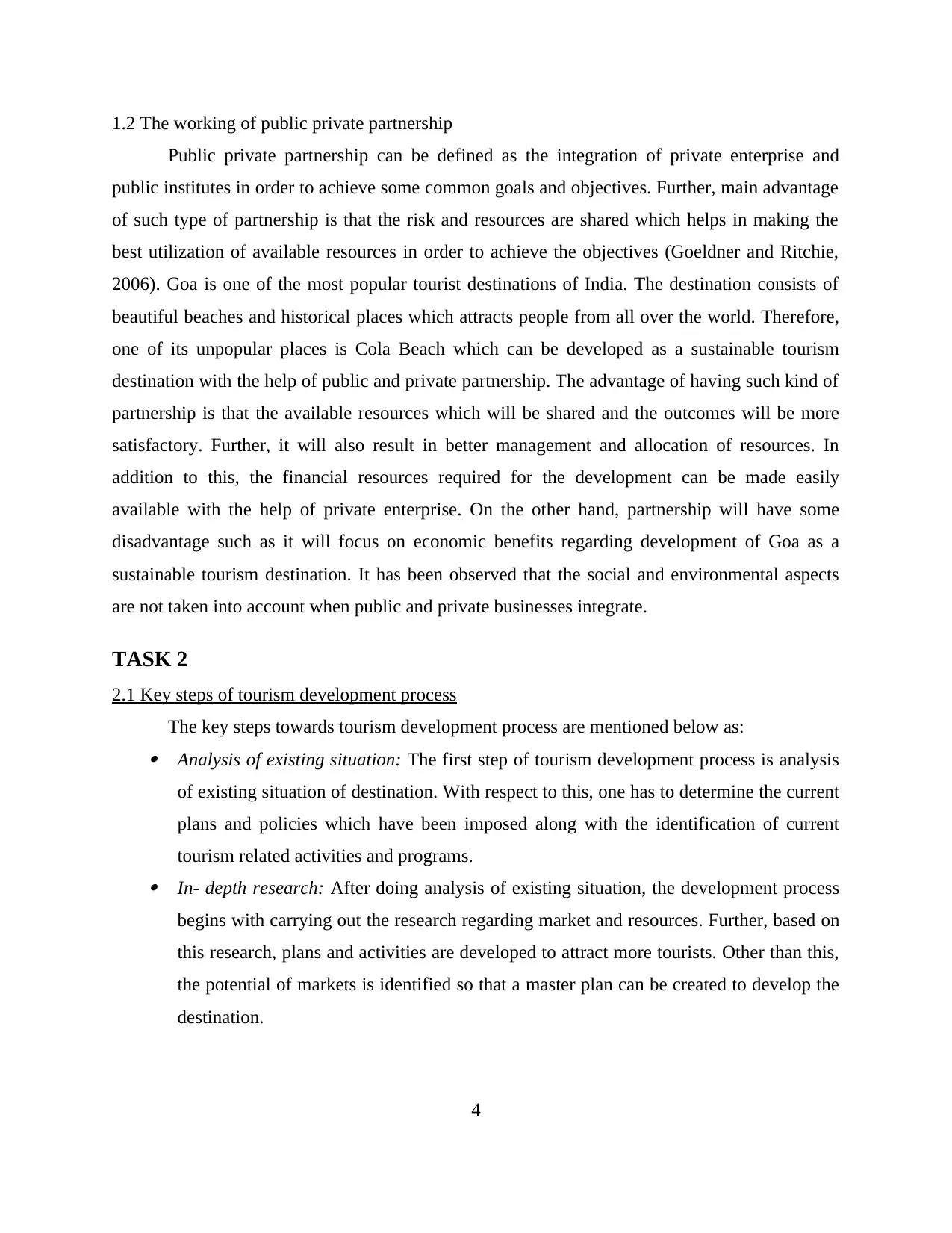
1.2 The working of public private partnership
Public private partnership can be defined as the integration of private enterprise and
public institutes in order to achieve some common goals and objectives. Further, main advantage
of such type of partnership is that the risk and resources are shared which helps in making the
best utilization of available resources in order to achieve the objectives (Goeldner and Ritchie,
2006). Goa is one of the most popular tourist destinations of India. The destination consists of
beautiful beaches and historical places which attracts people from all over the world. Therefore,
one of its unpopular places is Cola Beach which can be developed as a sustainable tourism
destination with the help of public and private partnership. The advantage of having such kind of
partnership is that the available resources which will be shared and the outcomes will be more
satisfactory. Further, it will also result in better management and allocation of resources. In
addition to this, the financial resources required for the development can be made easily
available with the help of private enterprise. On the other hand, partnership will have some
disadvantage such as it will focus on economic benefits regarding development of Goa as a
sustainable tourism destination. It has been observed that the social and environmental aspects
are not taken into account when public and private businesses integrate.
TASK 2
2.1 Key steps of tourism development process
The key steps towards tourism development process are mentioned below as: Analysis of existing situation: The first step of tourism development process is analysis
of existing situation of destination. With respect to this, one has to determine the current
plans and policies which have been imposed along with the identification of current
tourism related activities and programs. In- depth research: After doing analysis of existing situation, the development process
begins with carrying out the research regarding market and resources. Further, based on
this research, plans and activities are developed to attract more tourists. Other than this,
the potential of markets is identified so that a master plan can be created to develop the
destination.
4
Public private partnership can be defined as the integration of private enterprise and
public institutes in order to achieve some common goals and objectives. Further, main advantage
of such type of partnership is that the risk and resources are shared which helps in making the
best utilization of available resources in order to achieve the objectives (Goeldner and Ritchie,
2006). Goa is one of the most popular tourist destinations of India. The destination consists of
beautiful beaches and historical places which attracts people from all over the world. Therefore,
one of its unpopular places is Cola Beach which can be developed as a sustainable tourism
destination with the help of public and private partnership. The advantage of having such kind of
partnership is that the available resources which will be shared and the outcomes will be more
satisfactory. Further, it will also result in better management and allocation of resources. In
addition to this, the financial resources required for the development can be made easily
available with the help of private enterprise. On the other hand, partnership will have some
disadvantage such as it will focus on economic benefits regarding development of Goa as a
sustainable tourism destination. It has been observed that the social and environmental aspects
are not taken into account when public and private businesses integrate.
TASK 2
2.1 Key steps of tourism development process
The key steps towards tourism development process are mentioned below as: Analysis of existing situation: The first step of tourism development process is analysis
of existing situation of destination. With respect to this, one has to determine the current
plans and policies which have been imposed along with the identification of current
tourism related activities and programs. In- depth research: After doing analysis of existing situation, the development process
begins with carrying out the research regarding market and resources. Further, based on
this research, plans and activities are developed to attract more tourists. Other than this,
the potential of markets is identified so that a master plan can be created to develop the
destination.
4
Paraphrase This Document
Need a fresh take? Get an instant paraphrase of this document with our AI Paraphraser

Developing action plan and strategies: This is the last step in tourism development
process. In addition to this, based upon the market and resources, research an action
plan and strategies is made to develop the tourist destination.
2.2 Significance of interactive planning
Interactive planning can be defined as the concept which highlights the fact that the
activities of planning are important than the action plan. Further, during the process of planning,
all the stakeholders are invited to become a part of planning and to give their valuable
suggestions (Mowforth and Munt, 2008). The concept of interactive planning will be helpful in
developing Cola Beach, Goa as a sustainable tourism destination. One of the main advantages of
using interactive planning is that it is a continuous process which never stars and stops. The
involvement of various stakeholders such as local people, private enterprise, government and
supplier will help in making effective plans for sustainable development. Government will play a
major role in framing the policies and regulations for destination. On the other hand, during
planning, local people will also play an important role as they will help in determining the
additional amenities and facilities which can be developed at Cola Beach, Goa. The funds
required for development process will be arranged from the private enterprise. Therefore, it can
be stated that the interactive planning will play a significant role in the development of Cola
Beach as a sustainable tourism destination.
2.3 The impact of tourism and range of methods
Tourism has various impacts on the economic, social and environment conditions of a
country. It has been identified that there are some positive and negative impacts of tourism on
the economy of a nation. Tourism helps in creating more employment opportunities and in
increasing the income level of people (Byrd, 2007). Further, it is one of the major sources of
revenue generation for government of many countries. On the other hand, it can be stated that a
successful tourism always rely on better and effective infrastructure. Thus, the cost of developing
better infrastructure falls directly on the government of a country. The jobs which are created are
also seasonal in nature and most of the employees are paid poorly. In terms of society, tourism
has both negative and positive social impact. The local community gets benefits form good
infrastructure and facilities developed by government to attract more tourists. On the other hand,
5
process. In addition to this, based upon the market and resources, research an action
plan and strategies is made to develop the tourist destination.
2.2 Significance of interactive planning
Interactive planning can be defined as the concept which highlights the fact that the
activities of planning are important than the action plan. Further, during the process of planning,
all the stakeholders are invited to become a part of planning and to give their valuable
suggestions (Mowforth and Munt, 2008). The concept of interactive planning will be helpful in
developing Cola Beach, Goa as a sustainable tourism destination. One of the main advantages of
using interactive planning is that it is a continuous process which never stars and stops. The
involvement of various stakeholders such as local people, private enterprise, government and
supplier will help in making effective plans for sustainable development. Government will play a
major role in framing the policies and regulations for destination. On the other hand, during
planning, local people will also play an important role as they will help in determining the
additional amenities and facilities which can be developed at Cola Beach, Goa. The funds
required for development process will be arranged from the private enterprise. Therefore, it can
be stated that the interactive planning will play a significant role in the development of Cola
Beach as a sustainable tourism destination.
2.3 The impact of tourism and range of methods
Tourism has various impacts on the economic, social and environment conditions of a
country. It has been identified that there are some positive and negative impacts of tourism on
the economy of a nation. Tourism helps in creating more employment opportunities and in
increasing the income level of people (Byrd, 2007). Further, it is one of the major sources of
revenue generation for government of many countries. On the other hand, it can be stated that a
successful tourism always rely on better and effective infrastructure. Thus, the cost of developing
better infrastructure falls directly on the government of a country. The jobs which are created are
also seasonal in nature and most of the employees are paid poorly. In terms of society, tourism
has both negative and positive social impact. The local community gets benefits form good
infrastructure and facilities developed by government to attract more tourists. On the other hand,
5
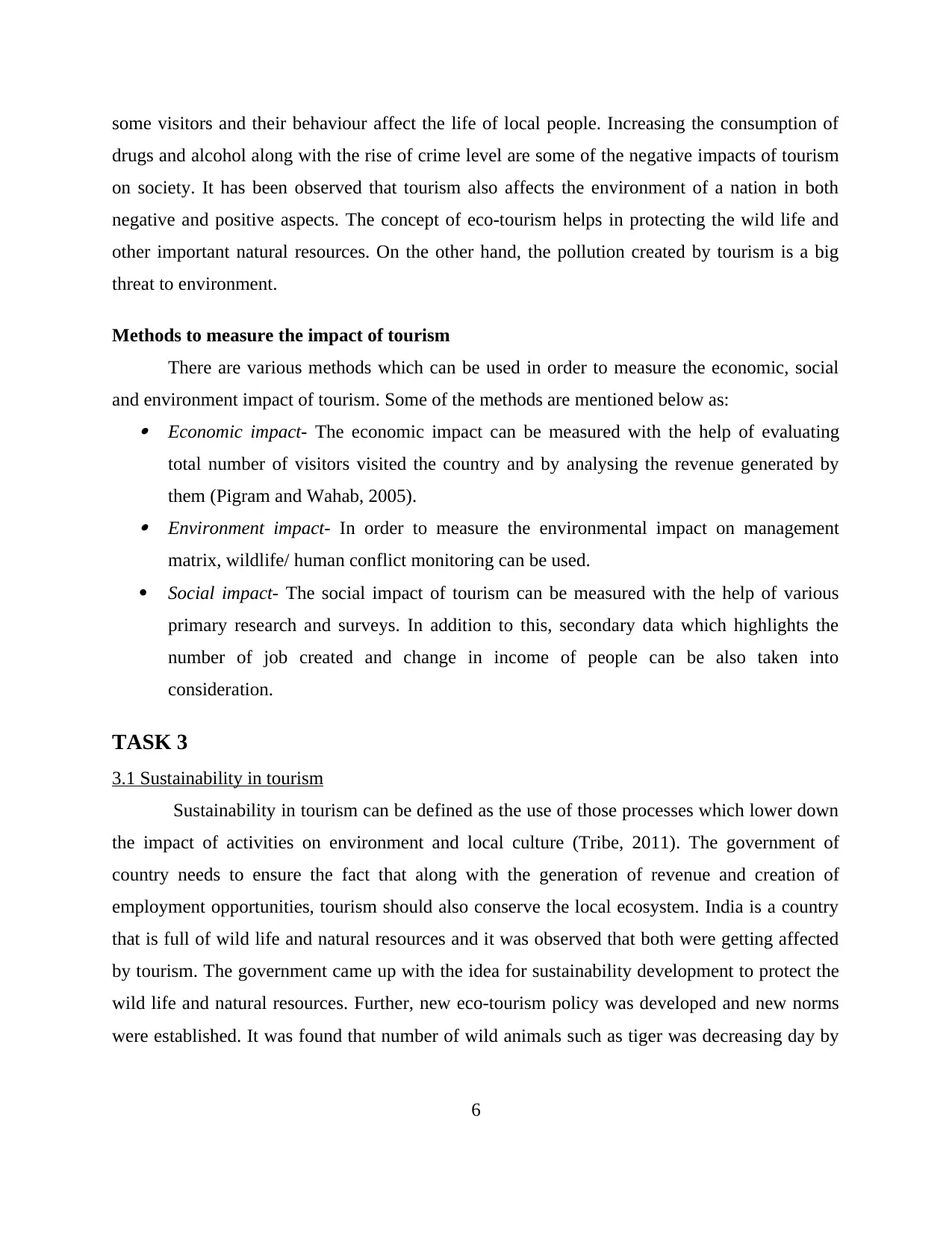
some visitors and their behaviour affect the life of local people. Increasing the consumption of
drugs and alcohol along with the rise of crime level are some of the negative impacts of tourism
on society. It has been observed that tourism also affects the environment of a nation in both
negative and positive aspects. The concept of eco-tourism helps in protecting the wild life and
other important natural resources. On the other hand, the pollution created by tourism is a big
threat to environment.
Methods to measure the impact of tourism
There are various methods which can be used in order to measure the economic, social
and environment impact of tourism. Some of the methods are mentioned below as: Economic impact- The economic impact can be measured with the help of evaluating
total number of visitors visited the country and by analysing the revenue generated by
them (Pigram and Wahab, 2005). Environment impact- In order to measure the environmental impact on management
matrix, wildlife/ human conflict monitoring can be used.
Social impact- The social impact of tourism can be measured with the help of various
primary research and surveys. In addition to this, secondary data which highlights the
number of job created and change in income of people can be also taken into
consideration.
TASK 3
3.1 Sustainability in tourism
Sustainability in tourism can be defined as the use of those processes which lower down
the impact of activities on environment and local culture (Tribe, 2011). The government of
country needs to ensure the fact that along with the generation of revenue and creation of
employment opportunities, tourism should also conserve the local ecosystem. India is a country
that is full of wild life and natural resources and it was observed that both were getting affected
by tourism. The government came up with the idea for sustainability development to protect the
wild life and natural resources. Further, new eco-tourism policy was developed and new norms
were established. It was found that number of wild animals such as tiger was decreasing day by
6
drugs and alcohol along with the rise of crime level are some of the negative impacts of tourism
on society. It has been observed that tourism also affects the environment of a nation in both
negative and positive aspects. The concept of eco-tourism helps in protecting the wild life and
other important natural resources. On the other hand, the pollution created by tourism is a big
threat to environment.
Methods to measure the impact of tourism
There are various methods which can be used in order to measure the economic, social
and environment impact of tourism. Some of the methods are mentioned below as: Economic impact- The economic impact can be measured with the help of evaluating
total number of visitors visited the country and by analysing the revenue generated by
them (Pigram and Wahab, 2005). Environment impact- In order to measure the environmental impact on management
matrix, wildlife/ human conflict monitoring can be used.
Social impact- The social impact of tourism can be measured with the help of various
primary research and surveys. In addition to this, secondary data which highlights the
number of job created and change in income of people can be also taken into
consideration.
TASK 3
3.1 Sustainability in tourism
Sustainability in tourism can be defined as the use of those processes which lower down
the impact of activities on environment and local culture (Tribe, 2011). The government of
country needs to ensure the fact that along with the generation of revenue and creation of
employment opportunities, tourism should also conserve the local ecosystem. India is a country
that is full of wild life and natural resources and it was observed that both were getting affected
by tourism. The government came up with the idea for sustainability development to protect the
wild life and natural resources. Further, new eco-tourism policy was developed and new norms
were established. It was found that number of wild animals such as tiger was decreasing day by
6
⊘ This is a preview!⊘
Do you want full access?
Subscribe today to unlock all pages.

Trusted by 1+ million students worldwide
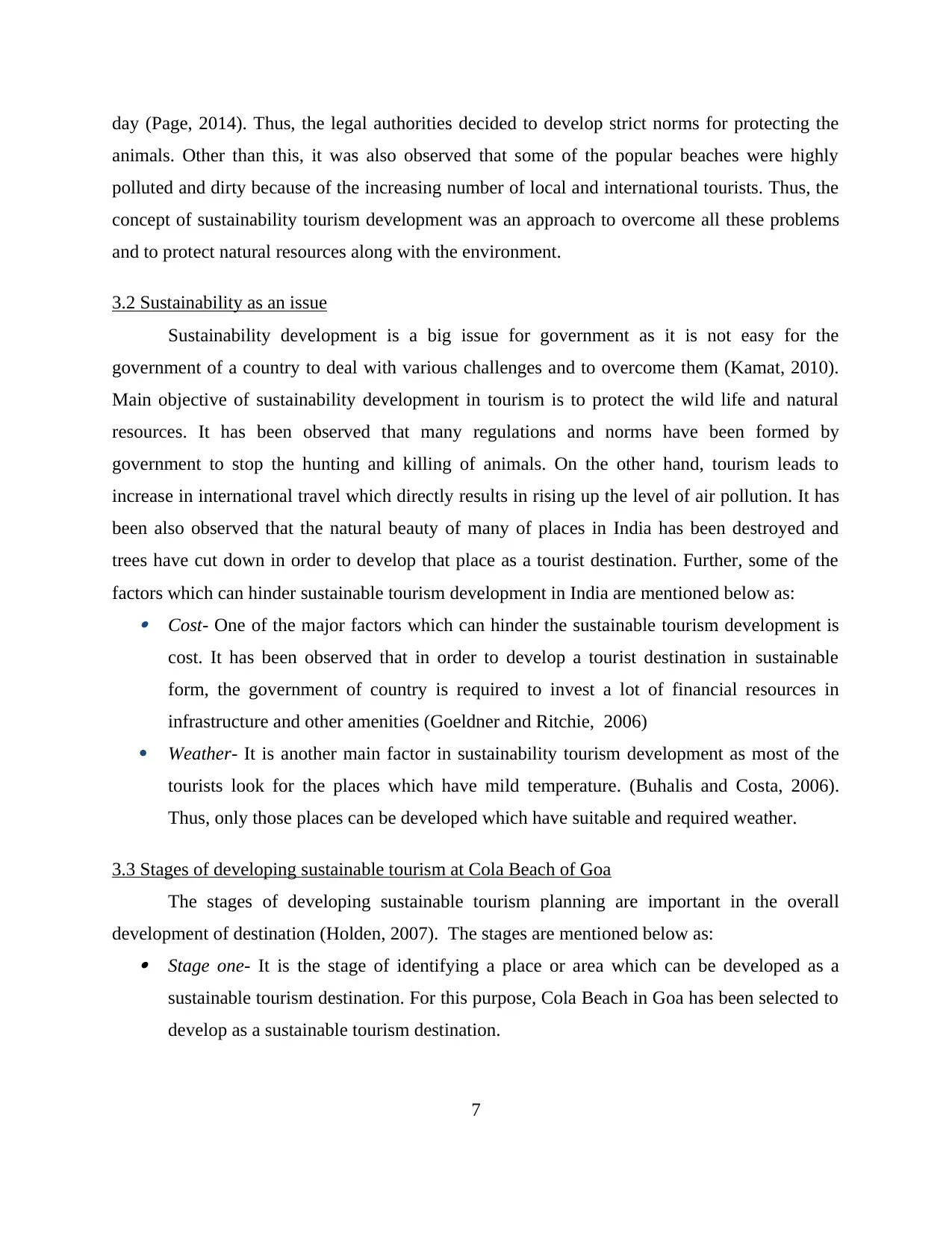
day (Page, 2014). Thus, the legal authorities decided to develop strict norms for protecting the
animals. Other than this, it was also observed that some of the popular beaches were highly
polluted and dirty because of the increasing number of local and international tourists. Thus, the
concept of sustainability tourism development was an approach to overcome all these problems
and to protect natural resources along with the environment.
3.2 Sustainability as an issue
Sustainability development is a big issue for government as it is not easy for the
government of a country to deal with various challenges and to overcome them (Kamat, 2010).
Main objective of sustainability development in tourism is to protect the wild life and natural
resources. It has been observed that many regulations and norms have been formed by
government to stop the hunting and killing of animals. On the other hand, tourism leads to
increase in international travel which directly results in rising up the level of air pollution. It has
been also observed that the natural beauty of many of places in India has been destroyed and
trees have cut down in order to develop that place as a tourist destination. Further, some of the
factors which can hinder sustainable tourism development in India are mentioned below as: Cost- One of the major factors which can hinder the sustainable tourism development is
cost. It has been observed that in order to develop a tourist destination in sustainable
form, the government of country is required to invest a lot of financial resources in
infrastructure and other amenities (Goeldner and Ritchie, 2006)
Weather- It is another main factor in sustainability tourism development as most of the
tourists look for the places which have mild temperature. (Buhalis and Costa, 2006).
Thus, only those places can be developed which have suitable and required weather.
3.3 Stages of developing sustainable tourism at Cola Beach of Goa
The stages of developing sustainable tourism planning are important in the overall
development of destination (Holden, 2007). The stages are mentioned below as: Stage one- It is the stage of identifying a place or area which can be developed as a
sustainable tourism destination. For this purpose, Cola Beach in Goa has been selected to
develop as a sustainable tourism destination.
7
animals. Other than this, it was also observed that some of the popular beaches were highly
polluted and dirty because of the increasing number of local and international tourists. Thus, the
concept of sustainability tourism development was an approach to overcome all these problems
and to protect natural resources along with the environment.
3.2 Sustainability as an issue
Sustainability development is a big issue for government as it is not easy for the
government of a country to deal with various challenges and to overcome them (Kamat, 2010).
Main objective of sustainability development in tourism is to protect the wild life and natural
resources. It has been observed that many regulations and norms have been formed by
government to stop the hunting and killing of animals. On the other hand, tourism leads to
increase in international travel which directly results in rising up the level of air pollution. It has
been also observed that the natural beauty of many of places in India has been destroyed and
trees have cut down in order to develop that place as a tourist destination. Further, some of the
factors which can hinder sustainable tourism development in India are mentioned below as: Cost- One of the major factors which can hinder the sustainable tourism development is
cost. It has been observed that in order to develop a tourist destination in sustainable
form, the government of country is required to invest a lot of financial resources in
infrastructure and other amenities (Goeldner and Ritchie, 2006)
Weather- It is another main factor in sustainability tourism development as most of the
tourists look for the places which have mild temperature. (Buhalis and Costa, 2006).
Thus, only those places can be developed which have suitable and required weather.
3.3 Stages of developing sustainable tourism at Cola Beach of Goa
The stages of developing sustainable tourism planning are important in the overall
development of destination (Holden, 2007). The stages are mentioned below as: Stage one- It is the stage of identifying a place or area which can be developed as a
sustainable tourism destination. For this purpose, Cola Beach in Goa has been selected to
develop as a sustainable tourism destination.
7
Paraphrase This Document
Need a fresh take? Get an instant paraphrase of this document with our AI Paraphraser
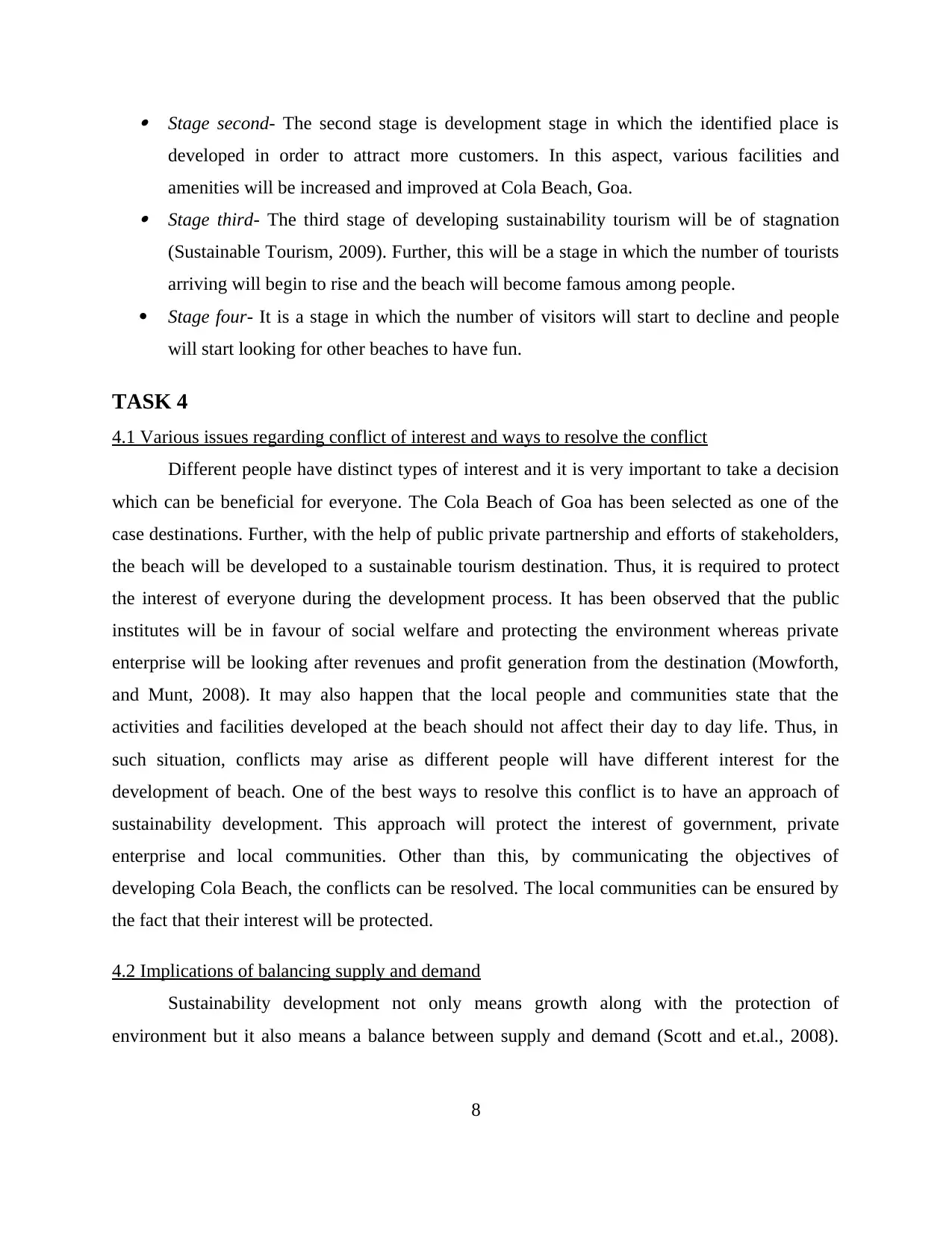
Stage second- The second stage is development stage in which the identified place is
developed in order to attract more customers. In this aspect, various facilities and
amenities will be increased and improved at Cola Beach, Goa. Stage third- The third stage of developing sustainability tourism will be of stagnation
(Sustainable Tourism, 2009). Further, this will be a stage in which the number of tourists
arriving will begin to rise and the beach will become famous among people.
Stage four- It is a stage in which the number of visitors will start to decline and people
will start looking for other beaches to have fun.
TASK 4
4.1 Various issues regarding conflict of interest and ways to resolve the conflict
Different people have distinct types of interest and it is very important to take a decision
which can be beneficial for everyone. The Cola Beach of Goa has been selected as one of the
case destinations. Further, with the help of public private partnership and efforts of stakeholders,
the beach will be developed to a sustainable tourism destination. Thus, it is required to protect
the interest of everyone during the development process. It has been observed that the public
institutes will be in favour of social welfare and protecting the environment whereas private
enterprise will be looking after revenues and profit generation from the destination (Mowforth,
and Munt, 2008). It may also happen that the local people and communities state that the
activities and facilities developed at the beach should not affect their day to day life. Thus, in
such situation, conflicts may arise as different people will have different interest for the
development of beach. One of the best ways to resolve this conflict is to have an approach of
sustainability development. This approach will protect the interest of government, private
enterprise and local communities. Other than this, by communicating the objectives of
developing Cola Beach, the conflicts can be resolved. The local communities can be ensured by
the fact that their interest will be protected.
4.2 Implications of balancing supply and demand
Sustainability development not only means growth along with the protection of
environment but it also means a balance between supply and demand (Scott and et.al., 2008).
8
developed in order to attract more customers. In this aspect, various facilities and
amenities will be increased and improved at Cola Beach, Goa. Stage third- The third stage of developing sustainability tourism will be of stagnation
(Sustainable Tourism, 2009). Further, this will be a stage in which the number of tourists
arriving will begin to rise and the beach will become famous among people.
Stage four- It is a stage in which the number of visitors will start to decline and people
will start looking for other beaches to have fun.
TASK 4
4.1 Various issues regarding conflict of interest and ways to resolve the conflict
Different people have distinct types of interest and it is very important to take a decision
which can be beneficial for everyone. The Cola Beach of Goa has been selected as one of the
case destinations. Further, with the help of public private partnership and efforts of stakeholders,
the beach will be developed to a sustainable tourism destination. Thus, it is required to protect
the interest of everyone during the development process. It has been observed that the public
institutes will be in favour of social welfare and protecting the environment whereas private
enterprise will be looking after revenues and profit generation from the destination (Mowforth,
and Munt, 2008). It may also happen that the local people and communities state that the
activities and facilities developed at the beach should not affect their day to day life. Thus, in
such situation, conflicts may arise as different people will have different interest for the
development of beach. One of the best ways to resolve this conflict is to have an approach of
sustainability development. This approach will protect the interest of government, private
enterprise and local communities. Other than this, by communicating the objectives of
developing Cola Beach, the conflicts can be resolved. The local communities can be ensured by
the fact that their interest will be protected.
4.2 Implications of balancing supply and demand
Sustainability development not only means growth along with the protection of
environment but it also means a balance between supply and demand (Scott and et.al., 2008).
8
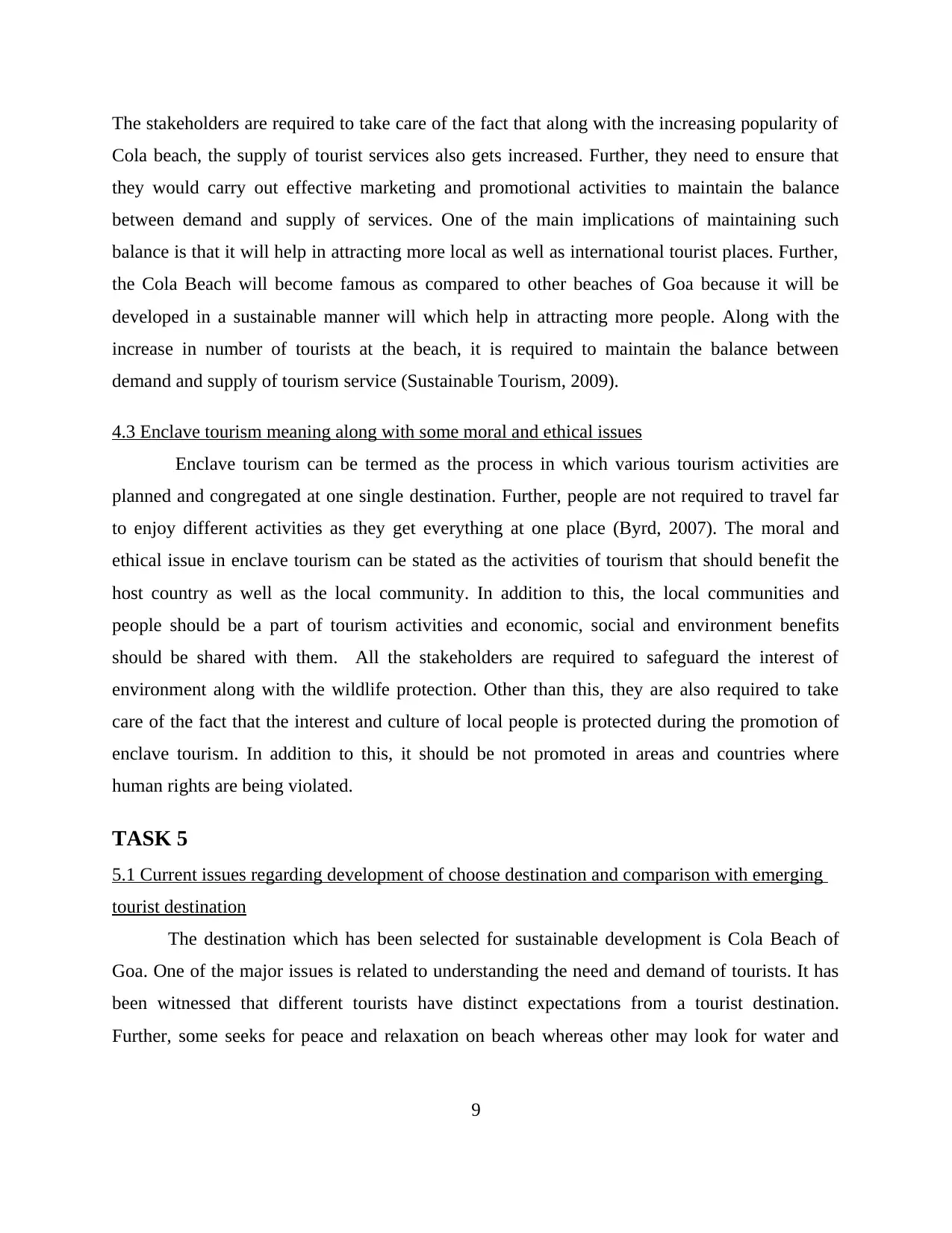
The stakeholders are required to take care of the fact that along with the increasing popularity of
Cola beach, the supply of tourist services also gets increased. Further, they need to ensure that
they would carry out effective marketing and promotional activities to maintain the balance
between demand and supply of services. One of the main implications of maintaining such
balance is that it will help in attracting more local as well as international tourist places. Further,
the Cola Beach will become famous as compared to other beaches of Goa because it will be
developed in a sustainable manner will which help in attracting more people. Along with the
increase in number of tourists at the beach, it is required to maintain the balance between
demand and supply of tourism service (Sustainable Tourism, 2009).
4.3 Enclave tourism meaning along with some moral and ethical issues
Enclave tourism can be termed as the process in which various tourism activities are
planned and congregated at one single destination. Further, people are not required to travel far
to enjoy different activities as they get everything at one place (Byrd, 2007). The moral and
ethical issue in enclave tourism can be stated as the activities of tourism that should benefit the
host country as well as the local community. In addition to this, the local communities and
people should be a part of tourism activities and economic, social and environment benefits
should be shared with them. All the stakeholders are required to safeguard the interest of
environment along with the wildlife protection. Other than this, they are also required to take
care of the fact that the interest and culture of local people is protected during the promotion of
enclave tourism. In addition to this, it should be not promoted in areas and countries where
human rights are being violated.
TASK 5
5.1 Current issues regarding development of choose destination and comparison with emerging
tourist destination
The destination which has been selected for sustainable development is Cola Beach of
Goa. One of the major issues is related to understanding the need and demand of tourists. It has
been witnessed that different tourists have distinct expectations from a tourist destination.
Further, some seeks for peace and relaxation on beach whereas other may look for water and
9
Cola beach, the supply of tourist services also gets increased. Further, they need to ensure that
they would carry out effective marketing and promotional activities to maintain the balance
between demand and supply of services. One of the main implications of maintaining such
balance is that it will help in attracting more local as well as international tourist places. Further,
the Cola Beach will become famous as compared to other beaches of Goa because it will be
developed in a sustainable manner will which help in attracting more people. Along with the
increase in number of tourists at the beach, it is required to maintain the balance between
demand and supply of tourism service (Sustainable Tourism, 2009).
4.3 Enclave tourism meaning along with some moral and ethical issues
Enclave tourism can be termed as the process in which various tourism activities are
planned and congregated at one single destination. Further, people are not required to travel far
to enjoy different activities as they get everything at one place (Byrd, 2007). The moral and
ethical issue in enclave tourism can be stated as the activities of tourism that should benefit the
host country as well as the local community. In addition to this, the local communities and
people should be a part of tourism activities and economic, social and environment benefits
should be shared with them. All the stakeholders are required to safeguard the interest of
environment along with the wildlife protection. Other than this, they are also required to take
care of the fact that the interest and culture of local people is protected during the promotion of
enclave tourism. In addition to this, it should be not promoted in areas and countries where
human rights are being violated.
TASK 5
5.1 Current issues regarding development of choose destination and comparison with emerging
tourist destination
The destination which has been selected for sustainable development is Cola Beach of
Goa. One of the major issues is related to understanding the need and demand of tourists. It has
been witnessed that different tourists have distinct expectations from a tourist destination.
Further, some seeks for peace and relaxation on beach whereas other may look for water and
9
⊘ This is a preview!⊘
Do you want full access?
Subscribe today to unlock all pages.

Trusted by 1+ million students worldwide
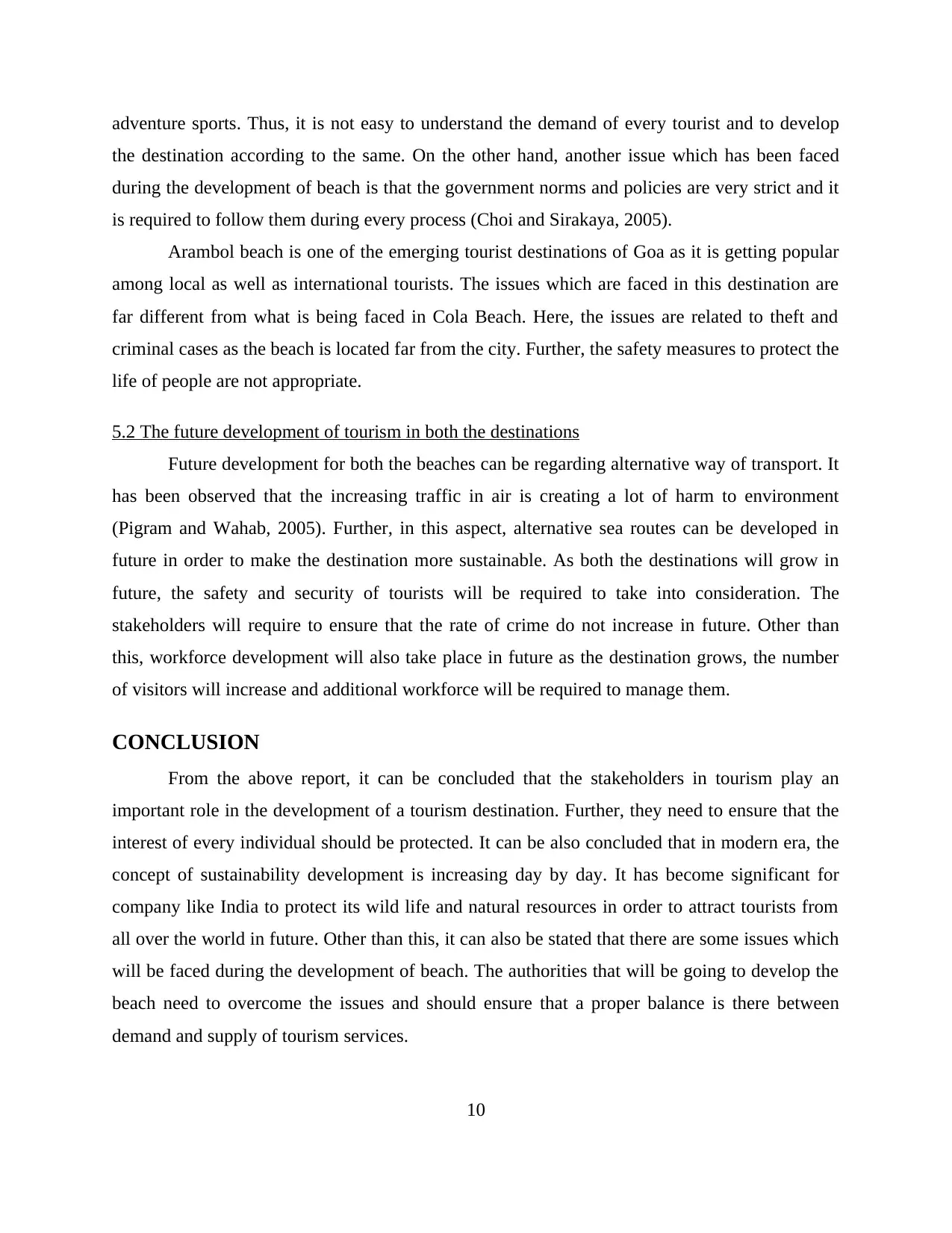
adventure sports. Thus, it is not easy to understand the demand of every tourist and to develop
the destination according to the same. On the other hand, another issue which has been faced
during the development of beach is that the government norms and policies are very strict and it
is required to follow them during every process (Choi and Sirakaya, 2005).
Arambol beach is one of the emerging tourist destinations of Goa as it is getting popular
among local as well as international tourists. The issues which are faced in this destination are
far different from what is being faced in Cola Beach. Here, the issues are related to theft and
criminal cases as the beach is located far from the city. Further, the safety measures to protect the
life of people are not appropriate.
5.2 The future development of tourism in both the destinations
Future development for both the beaches can be regarding alternative way of transport. It
has been observed that the increasing traffic in air is creating a lot of harm to environment
(Pigram and Wahab, 2005). Further, in this aspect, alternative sea routes can be developed in
future in order to make the destination more sustainable. As both the destinations will grow in
future, the safety and security of tourists will be required to take into consideration. The
stakeholders will require to ensure that the rate of crime do not increase in future. Other than
this, workforce development will also take place in future as the destination grows, the number
of visitors will increase and additional workforce will be required to manage them.
CONCLUSION
From the above report, it can be concluded that the stakeholders in tourism play an
important role in the development of a tourism destination. Further, they need to ensure that the
interest of every individual should be protected. It can be also concluded that in modern era, the
concept of sustainability development is increasing day by day. It has become significant for
company like India to protect its wild life and natural resources in order to attract tourists from
all over the world in future. Other than this, it can also be stated that there are some issues which
will be faced during the development of beach. The authorities that will be going to develop the
beach need to overcome the issues and should ensure that a proper balance is there between
demand and supply of tourism services.
10
the destination according to the same. On the other hand, another issue which has been faced
during the development of beach is that the government norms and policies are very strict and it
is required to follow them during every process (Choi and Sirakaya, 2005).
Arambol beach is one of the emerging tourist destinations of Goa as it is getting popular
among local as well as international tourists. The issues which are faced in this destination are
far different from what is being faced in Cola Beach. Here, the issues are related to theft and
criminal cases as the beach is located far from the city. Further, the safety measures to protect the
life of people are not appropriate.
5.2 The future development of tourism in both the destinations
Future development for both the beaches can be regarding alternative way of transport. It
has been observed that the increasing traffic in air is creating a lot of harm to environment
(Pigram and Wahab, 2005). Further, in this aspect, alternative sea routes can be developed in
future in order to make the destination more sustainable. As both the destinations will grow in
future, the safety and security of tourists will be required to take into consideration. The
stakeholders will require to ensure that the rate of crime do not increase in future. Other than
this, workforce development will also take place in future as the destination grows, the number
of visitors will increase and additional workforce will be required to manage them.
CONCLUSION
From the above report, it can be concluded that the stakeholders in tourism play an
important role in the development of a tourism destination. Further, they need to ensure that the
interest of every individual should be protected. It can be also concluded that in modern era, the
concept of sustainability development is increasing day by day. It has become significant for
company like India to protect its wild life and natural resources in order to attract tourists from
all over the world in future. Other than this, it can also be stated that there are some issues which
will be faced during the development of beach. The authorities that will be going to develop the
beach need to overcome the issues and should ensure that a proper balance is there between
demand and supply of tourism services.
10
Paraphrase This Document
Need a fresh take? Get an instant paraphrase of this document with our AI Paraphraser
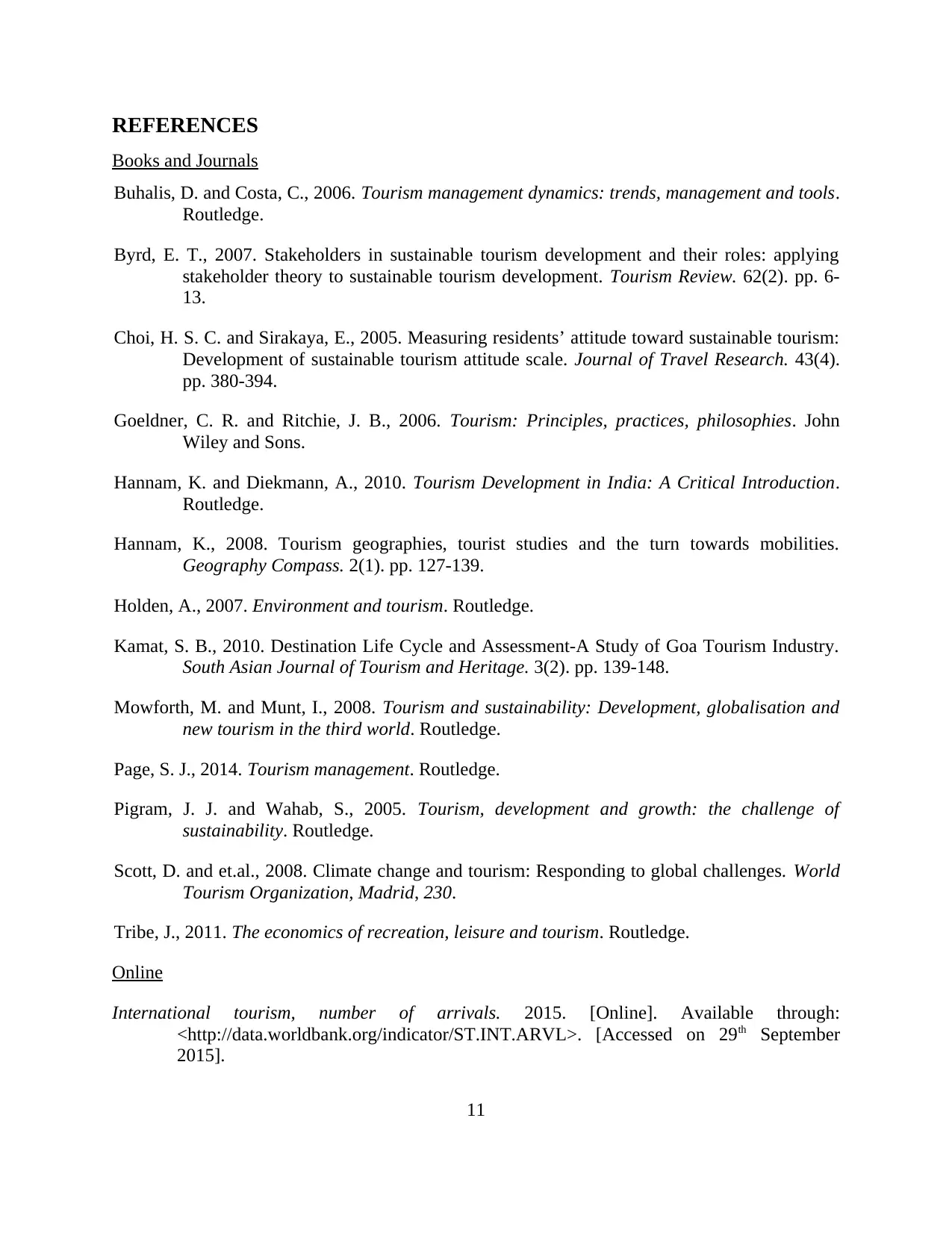
REFERENCES
Books and Journals
Buhalis, D. and Costa, C., 2006. Tourism management dynamics: trends, management and tools.
Routledge.
Byrd, E. T., 2007. Stakeholders in sustainable tourism development and their roles: applying
stakeholder theory to sustainable tourism development. Tourism Review. 62(2). pp. 6-
13.
Choi, H. S. C. and Sirakaya, E., 2005. Measuring residents’ attitude toward sustainable tourism:
Development of sustainable tourism attitude scale. Journal of Travel Research. 43(4).
pp. 380-394.
Goeldner, C. R. and Ritchie, J. B., 2006. Tourism: Principles, practices, philosophies. John
Wiley and Sons.
Hannam, K. and Diekmann, A., 2010. Tourism Development in India: A Critical Introduction.
Routledge.
Hannam, K., 2008. Tourism geographies, tourist studies and the turn towards mobilities.
Geography Compass. 2(1). pp. 127-139.
Holden, A., 2007. Environment and tourism. Routledge.
Kamat, S. B., 2010. Destination Life Cycle and Assessment-A Study of Goa Tourism Industry.
South Asian Journal of Tourism and Heritage. 3(2). pp. 139-148.
Mowforth, M. and Munt, I., 2008. Tourism and sustainability: Development, globalisation and
new tourism in the third world. Routledge.
Page, S. J., 2014. Tourism management. Routledge.
Pigram, J. J. and Wahab, S., 2005. Tourism, development and growth: the challenge of
sustainability. Routledge.
Scott, D. and et.al., 2008. Climate change and tourism: Responding to global challenges. World
Tourism Organization, Madrid, 230.
Tribe, J., 2011. The economics of recreation, leisure and tourism. Routledge.
Online
International tourism, number of arrivals. 2015. [Online]. Available through:
<http://data.worldbank.org/indicator/ST.INT.ARVL>. [Accessed on 29th September
2015].
11
Books and Journals
Buhalis, D. and Costa, C., 2006. Tourism management dynamics: trends, management and tools.
Routledge.
Byrd, E. T., 2007. Stakeholders in sustainable tourism development and their roles: applying
stakeholder theory to sustainable tourism development. Tourism Review. 62(2). pp. 6-
13.
Choi, H. S. C. and Sirakaya, E., 2005. Measuring residents’ attitude toward sustainable tourism:
Development of sustainable tourism attitude scale. Journal of Travel Research. 43(4).
pp. 380-394.
Goeldner, C. R. and Ritchie, J. B., 2006. Tourism: Principles, practices, philosophies. John
Wiley and Sons.
Hannam, K. and Diekmann, A., 2010. Tourism Development in India: A Critical Introduction.
Routledge.
Hannam, K., 2008. Tourism geographies, tourist studies and the turn towards mobilities.
Geography Compass. 2(1). pp. 127-139.
Holden, A., 2007. Environment and tourism. Routledge.
Kamat, S. B., 2010. Destination Life Cycle and Assessment-A Study of Goa Tourism Industry.
South Asian Journal of Tourism and Heritage. 3(2). pp. 139-148.
Mowforth, M. and Munt, I., 2008. Tourism and sustainability: Development, globalisation and
new tourism in the third world. Routledge.
Page, S. J., 2014. Tourism management. Routledge.
Pigram, J. J. and Wahab, S., 2005. Tourism, development and growth: the challenge of
sustainability. Routledge.
Scott, D. and et.al., 2008. Climate change and tourism: Responding to global challenges. World
Tourism Organization, Madrid, 230.
Tribe, J., 2011. The economics of recreation, leisure and tourism. Routledge.
Online
International tourism, number of arrivals. 2015. [Online]. Available through:
<http://data.worldbank.org/indicator/ST.INT.ARVL>. [Accessed on 29th September
2015].
11
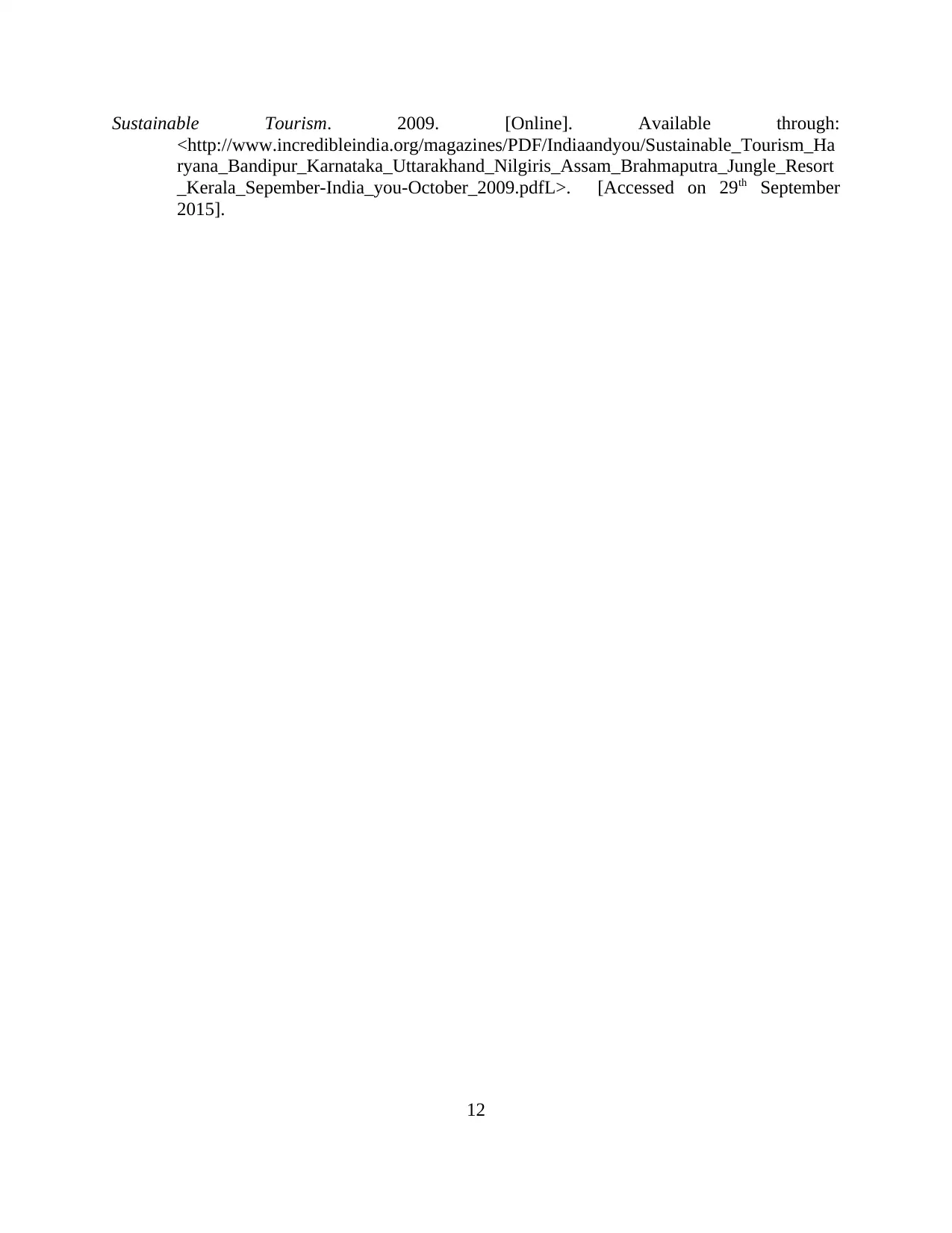
Sustainable Tourism. 2009. [Online]. Available through:
<http://www.incredibleindia.org/magazines/PDF/Indiaandyou/Sustainable_Tourism_Ha
ryana_Bandipur_Karnataka_Uttarakhand_Nilgiris_Assam_Brahmaputra_Jungle_Resort
_Kerala_Sepember-India_you-October_2009.pdfL>. [Accessed on 29th September
2015].
12
<http://www.incredibleindia.org/magazines/PDF/Indiaandyou/Sustainable_Tourism_Ha
ryana_Bandipur_Karnataka_Uttarakhand_Nilgiris_Assam_Brahmaputra_Jungle_Resort
_Kerala_Sepember-India_you-October_2009.pdfL>. [Accessed on 29th September
2015].
12
⊘ This is a preview!⊘
Do you want full access?
Subscribe today to unlock all pages.

Trusted by 1+ million students worldwide
1 out of 12
Related Documents
Your All-in-One AI-Powered Toolkit for Academic Success.
+13062052269
info@desklib.com
Available 24*7 on WhatsApp / Email
![[object Object]](/_next/static/media/star-bottom.7253800d.svg)
Unlock your academic potential
Copyright © 2020–2025 A2Z Services. All Rights Reserved. Developed and managed by ZUCOL.





